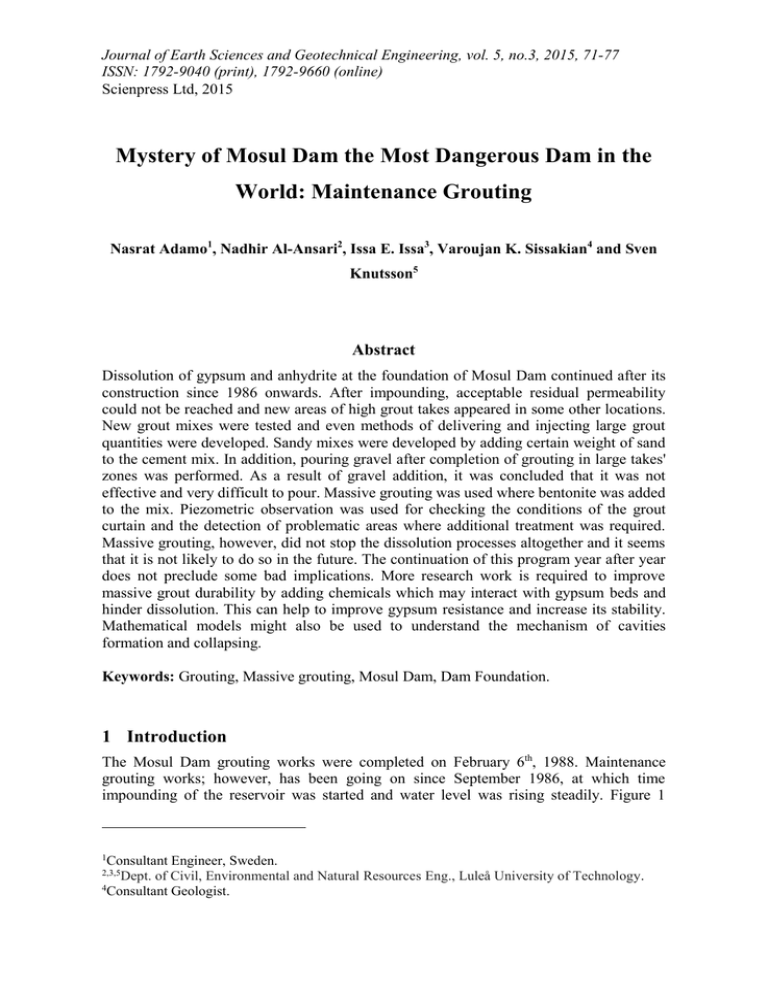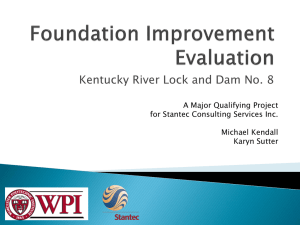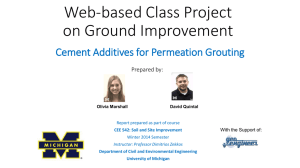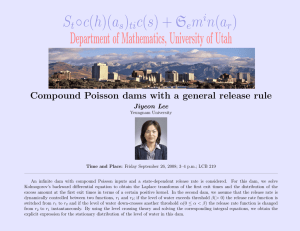Document 13729606
advertisement

Journal of Earth Sciences and Geotechnical Engineering, vol. 5, no.3, 2015, 71-77 ISSN: 1792-9040 (print), 1792-9660 (online) Scienpress Ltd, 2015 Mystery of Mosul Dam the Most Dangerous Dam in the World: Maintenance Grouting Nasrat Adamo1, Nadhir Al-Ansari2, Issa E. Issa3, Varoujan K. Sissakian4 and Sven Knutsson5 Abstract Dissolution of gypsum and anhydrite at the foundation of Mosul Dam continued after its construction since 1986 onwards. After impounding, acceptable residual permeability could not be reached and new areas of high grout takes appeared in some other locations. New grout mixes were tested and even methods of delivering and injecting large grout quantities were developed. Sandy mixes were developed by adding certain weight of sand to the cement mix. In addition, pouring gravel after completion of grouting in large takes' zones was performed. As a result of gravel addition, it was concluded that it was not effective and very difficult to pour. Massive grouting was used where bentonite was added to the mix. Piezometric observation was used for checking the conditions of the grout curtain and the detection of problematic areas where additional treatment was required. Massive grouting, however, did not stop the dissolution processes altogether and it seems that it is not likely to do so in the future. The continuation of this program year after year does not preclude some bad implications. More research work is required to improve massive grout durability by adding chemicals which may interact with gypsum beds and hinder dissolution. This can help to improve gypsum resistance and increase its stability. Mathematical models might also be used to understand the mechanism of cavities formation and collapsing. Keywords: Grouting, Massive grouting, Mosul Dam, Dam Foundation. 1 Introduction The Mosul Dam grouting works were completed on February 6th, 1988. Maintenance grouting works; however, has been going on since September 1986, at which time impounding of the reservoir was started and water level was rising steadily. Figure 1 1 Consultant Engineer, Sweden. Dept. of Civil, Environmental and Natural Resources Eng., Luleå University of Technology. 4 Consultant Geologist. 2,3,5 72 Nasrat Adamo et al. shows the quarantines of grouting takes injected from October 1986 up to October 2014. Efforts at that time were going on to close the already unsealed so called “Windows”, where design criteria for acceptable residual permeability could not be reached. Meanwhile, areas of high grout takes appeared in other locations. The general accepted cause for this was the dissolution of the gypsum and/or anhydride beds resulting in the deterioration of the curtain. So, it was clear that new methods had to be found to cope with the new situation. High hydraulic heads were steadily building up resulting in increased seepage flows through the curtain. New grout mixes were tested and even methods of delivering and injecting large grout quantities were developed. Maintenance grouting works continued from September 1986 up to now. Where the quantity of grout used from 1986 to 2015 reached 95657.43 tons. Techniques of Enlarged (massive) grouting as it is called now are used in addition to normal grouting that was already in use. Figure 1: Monthly grouting and water level at Mosul Dam. 2 Groutability Tests In this direction, much consideration and testing were performed during 1987 and 1988 to reach a satisfactory method for treating large takes' areas to ensure dam safety. This was called the” Groutability Tests Program”. Chemical grouts, such as gelling mixes and silicate mixes were overruled over fears of toxicity and inadequacy in case of existing of large cavities; in addition of high cost due to the large required quantities. Concrete use was investigated also and the concrete mix designated as type CT13 was tried. This mix has the following proportions; Cement weight= 500 kg. Sand (0-3mm) weight=694 kg. Gravel (3-8mm) weight= 1046 kg. Water volume = I L Total dry weight is 2240 kg. /m3 The use of this mix was abandoned due to technical difficulties and low productivity rate. Attention was turned then to use sandy mixes (SS) in addition to the cement mixes, which were already in current use. Sandy mixes were developed by adding certain weight of sand to the cement mix. And even pouring gravel after completion of grouting in large takes' zones. The performance of the additional grouting was done by drilling multiple patterns of bore holes (3 rows) at 1.5 m of hole's spacing. The new rows were to be Mosul Dam the Most Dangerous Dam in the World: Maintenance Grouting 73 located between the middle row and downstream row of the original curtain. Depths of these new holes should be 20 m below the original curtain and further deepening was instructed, where large grout take was experienced in the last grouted stage. Two alternative sequences of the grouting operations were experimented and results were evaluated as follows:i) To grout the three rows and pour gravel (3 – 8 mm) in all boreholes during injection of the grout mix to create a “Matrix”. ii) To grout the upstream and middle rows and pour gravel in the third row while injecting in those holes to create a “barrier”. In evaluating the results of the gravel addition, it was concluded that it is not effective and very difficult to pour, and that many high take zones were still not sealed after completing the grouting operation, so a decision was taken to discontinue its addition. Concerns were voiced as whether gypsum/anhydride dissolution was occurring at a rate higher than the filling by cement and sandy mixes and pouring of gravel. The final decision was a to try and inject large quantities of sandy and cement mixes in high take zones at a very high rate and by doing so the grout would fill the zone under consideration quickly and overcome the seepage flow and stop it. The industrial production and injection of the cement and sandy grout mixes was tried and it was called “Enlarged” or “Massive “grouting [1]. 3 Massive Grouting The proportions of the sandy mix (SS) were checked and after some trials the following mix design was thought to give best results: - Cement weight = 465 kg. - Sand /Cement ratio ≈2:1, so sand weight is 930 kg. - Water / Cement ratio =1:1, so water is 415 L. - Bentonite / Cement ratio = 4%, so bentonite weight is 18.6 kg. The total dry weight was 1413.6 kg/m3 and: The grading of used sand was 1 to 4 mm. In order to reach very high capacity for delivering this grout, mixing of the bentonite slurry was performed first in the grout mixing plant and then loaded in concrete truck mixers. The adding of cement and sand was then performed in to the mixers in the concrete batching plant. The grout mix was then transported from the concrete batching plant to the crest of the dam at section 77 and pumped down to the grouting gallery through steel service pipe placed in a bore hole 109.5 m long. This hole was drilled through the core in to the gallery. The pipe was black steel pipe OD 12.7 mm and ID 109 mm of flush joint type. At the bottom; inside the gallery an energy dissipater reduced the velocity of the pour mix and distributed it into an agitator tank with a capacity of approximately 1 m3 and to a grouting pump, which fed the mix into the injected hole by a high pressure flexible hose. This arrangement increased the delivery rate of grout 10 times more than the previous method and reached an average quantity of 20 m3 per shift. The maximum pumping distance inside the gallery was in the order of 180 m; in each direction. This limitation was caused by friction encountered by the mortar during its flowing in the injection pipeline. As this arrangement proved its efficiency, a second bore hole was driven and a service pipe was installed at section 71. A report states that a third service pipe was also installed later in section 88 to cover the whole length of the 74 Nasrat Adamo et al. problematic area, and a peak value of 400 m3 /day had been delivered in some instances [2]. 4 Detection of Problematic Zones Piezometric observation in Mosul Dam grouting gallery proved to be an exceptionally valuable tool for checking of the conditions of the grout curtain and the detection of problematic areas where additional treatment was required. For any pair of piezometers, if the pressure difference decreases, then this indicates an increase in seepage flow through the curtain at that location and the formation of a new dissolution path or cavity. It may be said; therefore, that this loss of head is a good indicator in such practical cases. In an electric-analogy study carried out on the curtain of a high dam in India [3] the following relationship was used for the evaluation of the deep grout curtain (Efficiency) efficacy:𝐸%= 𝐻−ℎ 𝐻 (1) E is the Efficacy (Efficiency) % H is the reading of the U/S piezometer h is the reading of the D/S piezometer H-h represent the loss of head, and when h → H then E → 0 In this equation, H and h are measured from the same datum. In this direction, a similar procedure was used in Mosul Dam [4] to establish areas of grout curtain deterioration and therefore, locate the dissolution zones. The efficiency index was determined as follows: 𝐸𝐹𝐹 % = 𝑈⁄𝑆𝑝−𝐷⁄𝑆𝑝 𝑅.𝐿−𝑇 (2) U/Sp is the upstream piezometer reading D/Sp is the downstream piezometer reading R.L is the Reservoir level T.L is the tailrace water level After the operation of the regulating dam at the downstream of the main dam, this equation started to give 2% – 3% errors due to the daily fluctuation of the regulating pond. The following modified equation was then used to eliminate these errors: 𝑈𝑝𝑠𝑡𝑒𝑎𝑚 𝐸𝐹𝐹 % = 𝑈⁄𝑆𝑝−𝑈⁄𝐹𝐿 𝑅.𝐿−𝑈⁄𝐹𝐿 (3) In this Equation U/Sp and R.L are same as above, and; U/FL is the level of the piezometer filter in the upstream piezometer This Equation gives the efficiency of the curtain in its upstream part and the results should vary between 50% to 100%. The efficiency of the curtain in its downstream part is given by: Mosul Dam the Most Dangerous Dam in the World: Maintenance Grouting 𝐷𝑜𝑤𝑛𝑠𝑡𝑟𝑒𝑎𝑚 𝐸𝐹𝐹 % = 𝑈⁄𝑆𝑝−𝐷⁄𝐹𝐿 𝑅.𝐿−𝐷⁄𝐹𝐿 75 (4) D/FL is the level of the piezometer filter in the downstream piezometer. The result can vary between 0% and 50% It is interesting to note that the Mosul Dam International Board of Experts (IBOE) formed of three top world dam experts was following the design and construction of Mosul Dam since 1979 and this also included the entire grouting curtainworks. The board approved the use of equation (ii) since 1987. The following interesting comment on this subject is taken from IBO report: “Of particular informational value was the ratio or index computed by the engineer to facilitate rapid appraisal and especially to get comparisons of situations at the same station with passage of time and comparisons of various stations. The index gives a measure of difference in head between upstream and downstream piezometric pairs divided by the difference between the headwater and tail water. The resulting number ranges, in practical examples from 0.2 up to 0.9. The higher the index is, the higher the effectiveness of the curtain in that location, with values of 0.3 to 0.4 and lower signaling a possible need for remedial action. In addition, at the same location, a gradual lowering of the index with passage of time signifies a deterioration of the curtain with need for remedial action [5]. In another IBOE report the following recommendation was made: -“100% efficiency is not possible and 70% is well within acceptability limit and repair should be done if efficiency goes below 50 %” [6]. Continuation of the piezometric observation resulted in the repeated application of both normal and massive grouting works up to now as a repair measure. The location of the major grout takes between sections 69 and 84 is shown in figure 2. There are other high grout take zones along the dam, but this area appears to be one of a major concern. The heavy line shown on the crest of the dam in figure 2 shows the approximate extent of this problem (high grout take) area. The green layers represent anhydride, while the orange represent gypsum breccia (nodules). The major grout takes are located close to the karst line associated with the conversion of anhydrite to gypsum (and also marking of the change from a high permeability to a lower permeability foundation), and also in the gypsum breccia(nodules). The white area between the green and orange layers consists of karstified limestone. It often contains voids, fractures, and fissures [7]. Figure 2: Major Grout takes in sections 69-84. 76 5 Nasrat Adamo et al. Future Prospects of Massive Grouting The massive grouting technique has so far proved its usefulness in sustaining the dissolution process into manageable condition using the present working capacities available at the dam site. Massive grouting; however, has not managed yet in terminating the dissolution processes altogether and it seems that it is not likely to do so in the future. The continuation of this program, year after year does not preclude some bad implications and it is of very high cost. Other consequences of a worst nature may be also considered. Today, the future consequences of Massive grouting cannot be guessed or quantified and many scenarios can be debated. The worst of such scenariosis the deterioration of an extensive mass of gypsum/anhydride layer close to the curtain and changing into a skeletal structure; as a result of repeated injection of grout mixes. Such a structure could collapse under increasing stress leaving big cavity or cavities behind. Concentrated seepage flow will then attack what remains of the curtain washing large areas of it. The invigorated solution and collapsing process that follows can progress very rapidly and create a situation, which exceeds the present available technical capacity of massive grouting. In a runaway situation, like this where the rapid deterioration of the foundation continues; adownward sinking failure of the dam can occur once the layers close to the dam base are affected. The sudden failure of Mosul Dam will result in a huge catastrophe. Massive grouting can be looked at as a temporary solution that may delay the occurrence of such an event, but it will not give the final solution. Such solutions have been discussed for the past thirty years or so. At the time being, research work is required to improve massive grout durability by adding chemicals, which may interact with the gypsum beds and form micro films around them and hinder dissolution. This can help to improve the gypsum resistance and increase its stability. Mathematical models may be also studied to understand the mechanism of cavities formation and collapsing to have a clear picture of the consequence of such processes. 6 Conclusions Foundation of Mosul Dam lies on the Fatha Formation, which is composed of marl, limestone, gypsum and anhydrite. Limestone beds under the foundation of the dam are highly karstified. The contractors used grouting to fill the cavities, fissures and joints during the construction period 1984 – 1986. When Mosul Dam Reservoir was first impounded in 1986, it was noticed that dissolution of gypsum and anhydrite at the foundation of Mosul Dam has continued. Despite the grouting operation that took place, acceptable residual permeability was not reached. In addition, new seepage locations were noticed. In view of the situation, studies were conducted to solve the problem. Grout mixes were examined and even methods of delivering and injecting large grout quantities were developed. Sandy mixes were developed by adding certain weight of sand to the cement mix. In addition, pouring gravel after completion of grouting in large takes' zones was performed. Continuous inspections showed that using gravel was not effective and very hard to handle. Later, the mix used was Massive grouting, where bentonite was added to the mix. The composition of the mixture was as follow: Cement weight = 465 kg, Sand/Cement ratio ≈ 2:1, so sand weight is 930 kg, Water / Cement ratio =1:1, so water is 415 L, Mosul Dam the Most Dangerous Dam in the World: Maintenance Grouting 77 Bentonite / Cement Ratio = 4%, so bentonite weight is 18.6 kg. The total dry weight of the mix was 1413.6 kg/m3. For checking of the conditions of the grout curtain and the detection of problematic areas where additional treatment was required; hence piezometric observations were used. Piezometric observation continued and resulted in the repeated application of both normal and massive grouting works up to now as a repair measure, where the grout used from 1986 to 2014 reached 95657.43 tons. Massive grouting did not prevent the dissolution processes of gypsum and anhydrite altogether and it seems that it is not likely to do so in the future. More research work is required to improve massive grout durability. Adding chemicals to the grout, which may interact with gypsum and hinder dissolution? This can help to improve gypsum resistance and increase its stability. Mathematical models might also be used to understand the mechanism of cavities formation and collapsing. ACKNOWLEDGEMENTS: The authors would like to thank all individuals for their help and assistance in this work. Special thanks are forwarded to Mr. Mohammed Dhari, the Construction Advisor of the Iraqi Ministry of Water Resources for his kind assistance, encouragement and support. The research presented has been financially supported by Luleå University of Technology, Sweden and by “Swedish Hydropower Centre—SVC” established by the Swedish Energy Agency, Elforsk and SvenskaKraftnät together with Luleå University of Technology, The Royal Institute of Technology, Chalmers University of Technology and Uppsala University. Their support is highly appreciated. References [1] [2] [3] [4] [5] [6] [7] Rodio-Keller, Mosul Dam, Massive Grouting -Technical Note, Ministry of Irrigation, Baghdad, Iraq, Nov.1988. Public Authority of Dams and Reservoirs, Report on Mosul Dam Conditions since start of operation until the present, Ministry of Irrigation, Baghdad, Iraq, Nov.1995. Goel, M.G. and Sharma, B.N., Efficacy of Grout Curtain at Ramganga Dam, The First Conference on Case Histories in Geotechnical Engineering, The University of Missouri of Science and Technology, USA,1984. General Meeting on the Safety of Iraqi Dams, Technical Report on Saddam (Mosul) Dam, Ministry of Irrigation, Baghdad, Iraq, Oct, 2000. IBOE, International Board of Experts, Interim Meeting Report, Ministry of Irrigation, Baghdad, Iraq, May1988a. IBOE, International Board of Experts, 23rd Meeting Report, Ministry of Irrigation, Baghdad, Iraq, Nov.1988. International Washington Group and Black and Veatch JV, Mosul Dam Study Final Report, Ministry of Irrigation, Baghdad, Iraq, Aug.2005.


